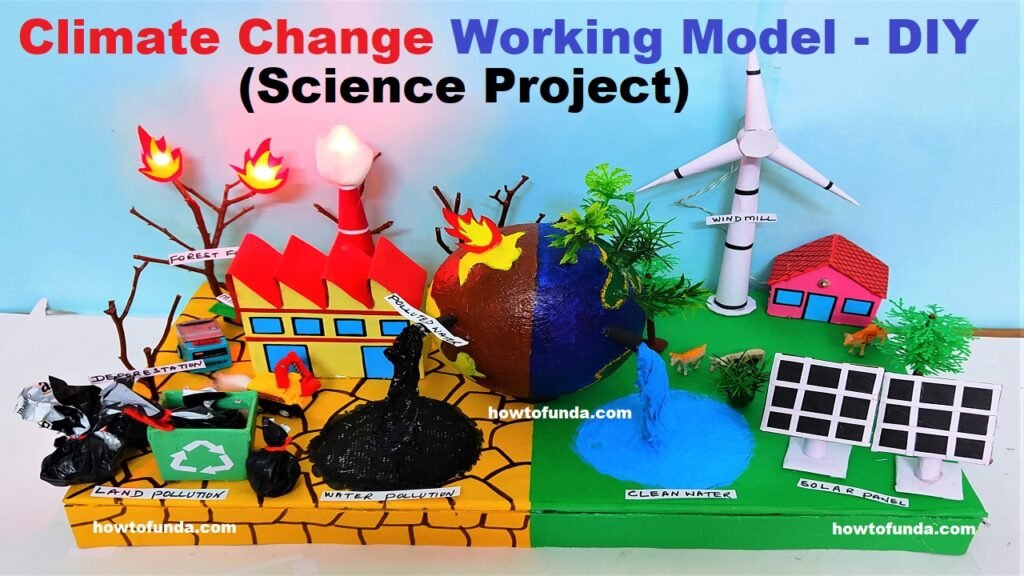1. What is climate change?
- Answer: Climate change refers to long-term changes in temperature, precipitation, wind patterns, and other aspects of the Earth’s climate system.

2. What is the primary driver of current climate change?
- Answer: Human activities, particularly the burning of fossil fuels and deforestation, are the primary drivers of the current climate change, leading to an increase in greenhouse gas concentrations.
3. How do greenhouse gases contribute to climate change?
- Answer: Greenhouse gases trap heat in the Earth’s atmosphere, leading to the warming of the planet. Human activities, such as burning fossil fuels, release additional greenhouse gases, enhancing the natural greenhouse effect.
4. What are the main greenhouse gases responsible for climate change?
- Answer: Carbon dioxide (CO2), methane (CH4), nitrous oxide (N2O), and fluorinated gases are the main greenhouse gases responsible for climate change.
5. How does deforestation contribute to climate change?
- Answer: Deforestation contributes to climate change by reducing the number of trees that absorb CO2. Trees act as carbon sinks, and their removal leads to an increase in atmospheric CO2 levels.
6. What is the difference between weather and climate?
- Answer: Weather refers to short-term atmospheric conditions in a specific location, while climate represents long-term patterns of temperature, precipitation, and other atmospheric elements in a region.
7. How does climate change impact sea levels?
- Answer: Climate change contributes to rising sea levels through the melting of glaciers and polar ice caps and the thermal expansion of seawater as it warms.
8. How does climate change affect extreme weather events?
- Answer: Climate change increases the frequency and intensity of extreme weather events, including heatwaves, hurricanes, droughts, and heavy rainfall.
9. How do scientists study past climate changes?
- Answer: Scientists study past climate changes through various methods, including analyzing ice cores, tree rings, sediment layers, and historical records.
10. What is the role of the Intergovernmental Panel on Climate Change (IPCC)?
Answer: The IPCC assesses scientific information related to climate change, providing policymakers with comprehensive reports on the state of climate science, impacts, and mitigation strategies.
11. How does climate change impact biodiversity?
Answer: Climate change threatens biodiversity by altering habitats, disrupting ecosystems, and affecting the distribution and behavior of species. Some may struggle to adapt or face increased risks of extinction.
12. Why is the Arctic particularly vulnerable to climate change?
Answer: The Arctic is vulnerable due to the amplification of warming in polar regions, leading to the rapid melting of ice, changes in ecosystems, and impacts on indigenous communities.
13. What is the role of oceans in climate regulation?
Answer: Oceans play a crucial role in climate regulation by absorbing CO2 and heat. However, increased CO2 absorption leads to ocean acidification, impacting marine ecosystems.
14. How does climate change affect agriculture?
Answer: Climate change affects agriculture by altering growing seasons, precipitation patterns, and the frequency of extreme weather events, impacting crop yields and food security.
15. What is the Paris Agreement, and why is it significant in addressing climate change? – Answer: The Paris Agreement is an international treaty that aims to limit global warming to well below 2 degrees Celsius above pre-industrial levels. It encourages countries to set and achieve emission reduction targets.
16. How does climate change impact water resources? –
Answer: Climate change affects water resources by altering precipitation patterns, leading to droughts or floods, and influencing the availability and distribution of freshwater.
17. How can individuals contribute to mitigating climate change?
Answer: Individuals can contribute by reducing energy consumption, using renewable energy sources, adopting sustainable practices, supporting conservation efforts, and advocating for climate-friendly policies.
18. How does the loss of ice in polar regions contribute to climate change?
Answer: The loss of ice in polar regions reduces the Earth’s surface albedo, leading to increased absorption of sunlight and further warming. It also contributes to rising sea levels.
19. What is the relationship between climate change and social justice?
Answer: Climate change exacerbates existing social inequalities, disproportionately affecting vulnerable communities and marginalized groups. Addressing climate change is crucial for achieving social justice.
20. How does climate change impact human health?
Answer: Climate change affects human health through increased heat-related illnesses, changes in disease patterns, the spread of vector-borne diseases, and disruptions to food and water supplies.
21. Why is the melting of permafrost a concern in the context of climate change?
Answer: The melting of permafrost releases stored methane, a potent greenhouse gas, into the atmosphere, contributing to the amplification of global warming.
22. What role do forests play in mitigating climate change?
Answer: Forests act as carbon sinks, absorbing CO2 through photosynthesis. Deforestation reduces this capacity, contributing to higher atmospheric CO2 levels.
23. How do scientists use climate models to understand future scenarios?
Answer: Climate models simulate Earth’s climate system, helping scientists project future climate scenarios under different emission scenarios and assess potential impacts.
24. Why is it important for countries to collaborate in addressing climate change?
Answer: Climate change is a global challenge that requires international cooperation. Countries must work together to reduce emissions, adapt to changes, and address shared environmental concerns.
25. Can climate change be reversed, and what is the urgency in addressing it?
Answer: While some impacts are irreversible, immediate and sustained efforts to reduce emissions and adapt to changes can mitigate the severity of future impacts. Urgency is crucial to limit the extent of damage and protect future generations.

